Morning glory: varieties, planting and care

Morning glory is a culture that belongs to the bindweed family. There are about 500 varieties in it: annuals, perennials, evergreen shrubs and trees. Many of them are climbers and climbers.

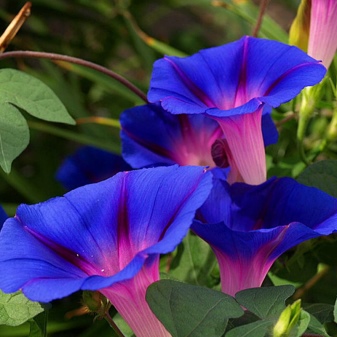
Peculiarities
While these plants are mainly grown for beautiful flowers, some varieties are cultivated for their foliage. For example, the popular Blackie vine (ipomoea batatas blackie).
Visually, the shoots of the plant resemble a vine. The stem can reach 8 meters, but on average does not exceed three. The leaves are heart-shaped.
Funnel-shaped flowers (they are also called "gramophone"). The diameter of the flower can reach 15 cm. There are a lot of colors: blue, purple, pink, white and others. Flowering lasts from July until the first frost.
The seeds are highly toxic when eaten. For example, the seed of the tricolor variety contains small amounts of the hallucinogen LSD. It has been used medicinally in the treatment of various mental disorders.
Morning glory is mostly grown in garden plots and much less often indoors. But quite often it is planted to decorate balconies, loggias and entrances.



Beneficial features
Some parts of the morning glory are used by humans. For example, morning glory pes-caprae has the following uses:
- the juice squeezed from the plant is used in Malaysia to treat fish bites;
- the leaves are used in Indonesia to speed up the healing of boils;
- juice from young leaves is boiled in coconut oil and used to treat ulcers, and the seeds, along with areca nuts, are taken for abdominal pain and cramps;
- in the Philippines, boiled leaves are used to treat rheumatism.
Scientists are beginning to consider sweet potatoes (I. batatas) not only as a source of food.
Certain properties of the leaves of this plant were found to be antimicrobial. This was a discovery from a 2007 USDA study.
The study was conducted to determine the growth of bacteria that can be inhibited by cultured sweet potato leaves.

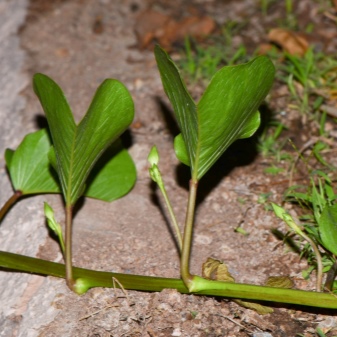
The results of this experiment led the researchers to conclude that sweet potato leaves definitely contain E. coli-resistant antibacterial compounds. In addition, the growth rate of saphylococcus aureus (the type of bacteria responsible for staphylococcal infections) was also significantly reduced by chemical compounds found in sweet potato leaves.
Hence, these leaves have a promising future by preventing the growth of bacteria that cause food poisoning from some foods and may even help with certain skin infections.
Perennial morning glory can grow in the winter in an apartment and even on the street. However, it is still more suitable for the southern regions, since its frost resistance is rather low.
Growing morning glory in pots is quite possible. They are even good for decorating a terrace or balcony. For this:
- choose a pot that is wide enough, about 30 cm in size;
- make sure there are holes in the bottom of the pot and place a layer of clay pebbles on the bottom;
- fill the pot with a mixture of soil for flower plants;
- water without flooding the plant.
More details about the features of growing - below.



Types and varieties
The best types of morning glory.
- "Serenade" Is a very showy variety with bright red flowers. Height - up to 3 meters. The flowers are about 8 cm in diameter. It blooms from late July to October.

- Picota - the plant is about 2.5 meters long. The flowers are about 10 cm in diameter. The color is bright blue. The petals have a thin white rim. It blooms for a long time - from late July to the first frost.

- "Milky Way" - shoots can reach 3 meters. The flowers are up to 10 cm in diameter. The color is white with purple strokes on the petals. The variety is very delicate and elegant.

- "Morning Glory" Are fast-growing vines that produce large, fragrant flowers. However, these beautiful plants can become aggressive terry weeds if left unchecked.

- Moonflower Is a tropical American plant. Reaches 6 m in length. It has flashlight-like flowers up to 10 cm in diameter, opening in the shade.

- "Sky Blue" - has large blue flowers. They are located on the stem in the amount of 2-3 pieces. Flowers up to 10 cm in diameter.

- "Sky" - the plant blooms every day. Unpretentious care. The flowers are sky blue.
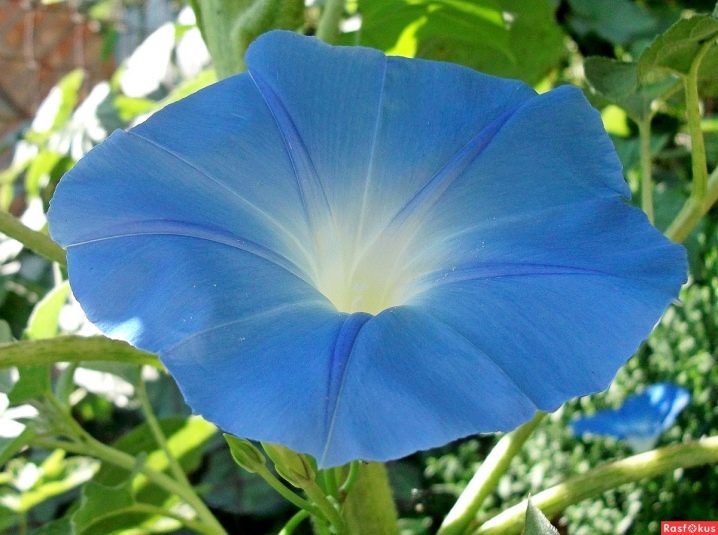
- "Ruby Lights" - has exceptionally bright flowers, up to 3 cm in size. It blooms until late autumn.

- Raffles - strong, tall plants with beautiful flowers. They rise up to 2 m. Therefore, they are used to create a flower fence or screen.


- "Flying saucer" - large flowers of blue shades, blooming every day.

- "Scarlett O'Hara" - red flowers. Large "gramophone", pleasing to the eye.
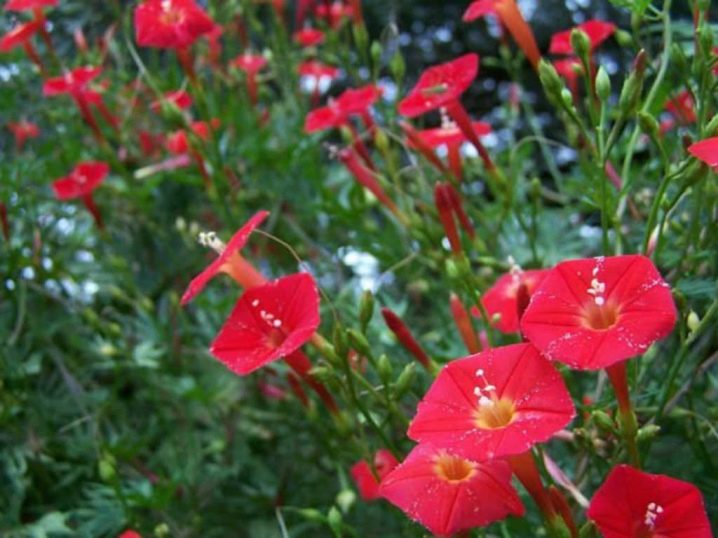
- "Mina Lobata" - Mexican plant with spike-shaped flowers that have a mixture of three colors: white, orange and red.

- "Beauty of Moscow" - a plant with heart-shaped three-lobed leaves. Flowers up to 7 cm scarlet.

In addition, the following varieties of morning glory are quite popular: "Lady Hamilton", "Kikyo-zaki", ampelous, "Giselle", "Red Star", "Summer Joy" and others.
Growing conditions
Like any other plant, the morning glory has its own nuances in growing. Let's get acquainted with them.
Morning glory loves sunlight. Therefore, the flowers should receive as much direct sunlight as possible, especially when the seedlings are still young. Keep houseplants near a south-facing window (or a north-facing window if you live in the Southern Hemisphere). The ideal soil temperature for germination is around + 20-30ºC.
Keep the soil moist until real leaves appear. A young plant may not germinate or die if the soil dries out. Germination lasts 5–21 days (but usually within a week). The seedlings are less vulnerable when the first true leaves appear (the first leaves that appear are called cotyledons and differ markedly from the real ones).
If you started planting plants indoors, then when the seedlings are well rooted and the last frost has passed, take them outside. Try to keep the soil moist during this acclimation period.
Once the seedlings are 15 cm tall, place a peg or trellis to raise the vine. Alternatively, plant the seedlings in a hanging basket, allowing the vines to cascade along the edge.

Mature plants are quite tolerant of dry soil. They may even require no watering at all in humid or cool climates. In hot weather, water once or twice a week. Over-watering can lead to overgrowth of stems with few flowers.
Give mature plants access to a trellis or pergola for shade... Or let them grow on a dead tree or post. They cannot climb flat surfaces, so hang a plastic net on the wall if you want vines to grow there.
Give your vines plenty of room, as some varieties can grow up to 5m in one season.
Check the morning glory for pests from time to time. Insect problems are uncommon, but it is worth checking for aphids and other insects from time to time. If a problem occurs, organic pesticides are commonly used. Usually each individual flower opens in the morning and dies off by the end of the day. This makes the morning glory one of the most interesting and beautiful plants for garden decoration.
The air temperature can change the color of the flower during the day. Remove dead vines in winter. Ipomoea can survive a mild frost, but in most cases they die at the beginning of winter.
The plant, in most cases, reproduces well on its own. And you don't have to constantly buy seeds for the next season. However, you may find that the entire garden begins to grow in vines.
Therefore, it is better to remove the dead vines immediately. New seeds usually grow from their original location, but you can also harvest seeds for planting by hand.
Don't use too much fertilizer. Fertilize first when your flowers are first planted. And then - no more than once a month. If you replenish the soil too often, you will stimulate foliage growth rather than flowering.


Sowing seeds
Let's talk about how to properly prepare seed material for growing morning glory.
- Buy packaged seeds morning glory or harvest pods from the plant.
- It is necessary to plant seeds after the last frost. When planting outdoors, wait until the last frost has passed and the soil begins to warm up. If you want to seed indoors, you can start 4-6 weeks before the end of the frost. Depending on your local conditions, it can be planted in late summer if you have a mild winter. If it gets colder in September, then you should not do the sowing. If the seeds are stored in winter, keep them in a dry, dark place.
- Some seeds are too difficult to germinate without first preparing them. To increase the chances of success, the seeds are usually cut with a nail file or soaked overnight in room temperature water. But if you have a lot of seeds, then you can skip this step and just accept the fact that not all seeds will germinate. True, some gardeners claim that soaking can cause rot or infection. And planting in moist soil (no soaking) will produce similar results, but with less risk.
- Some varieties do not tolerate transplanting well due to their thin root system. Therefore, it is best to choose one permanent location and always stick to it. If you are sowing the plant indoors, use a peat pot that you can bury in your garden if you want to take the plant outside. Morning glory can be successfully sown outdoors.
- Prepare a soil with good drainage. The mature plant is very tolerant of poor soil conditions, but the seeds need a well-draining nutrient medium. To do this, mix 1 part perlite with 3 parts soil or 1 part sand with 2 parts soil. Do not mix sand with heavy clay soil. There is no need to grow them in very rich, fertile soil - this can lead to fewer flowers in some varieties, especially "Sky Blue" and other varieties of tricolor morning glory.
- Plant each seed in a 1.25 cm hole and cover lightly with soil. If you plant them directly in the garden, then the choice of distance depends on the size of the variety and personal preference. It is a good idea to plant the seeds 5 cm apart and then expand to 15-30 cm apart once the seedlings are 7-8 cm high. At this height, the seedlings are well developed and less vulnerable to pests.

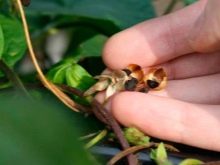

To plant crops in an apartment, you will need the following.
- Prepare pots or flower boxes for the balcony.
- As a soil, you can use purchased soil with the addition of vermiculite. A good drainage layer is required.
- It is necessary to prepare a site for culture.
- The seedlings are placed in containers. The distance should be about 20 cm.They can also be planted in separate containers.
- Since plants are usually grown on a balcony or loggia, it is important to protect them from drafts or wind. Direct sunlight is also undesirable.

Planting seedlings in open ground
In the open air (for example, in the country), seedlings or seeds are planted in May, when the soil is warmed up, and the threat of freezing has already passed.
The distance between plants when planting should be not less than 20 cm. When planting seeds, consider the required distance between them.
When planting seeds outdoors, consider the following nuances.
- Wind is dangerous to crops as it can break stems and damage flowers.
- The plant does not like excess sunlight. Therefore, it is better to plant morning glory in partial shade.
- The soil should not be too fertile, because the plant will develop strongly in greenery, and the flowering will not be as intense and plentiful.
- Ipomoea should be planted near supports - it can be a tree, a fence, a fence or special spacers in the form of nets or stretched wires.
- Soil enrichment is carried out in spring and autumn. In the fall, you need to apply complex mineral fertilizers, and in the spring - organic ones.
- Watering should be done sparingly so as not to flood the soil.
In general, there is no particularly significant difference between indoor and outdoor care.
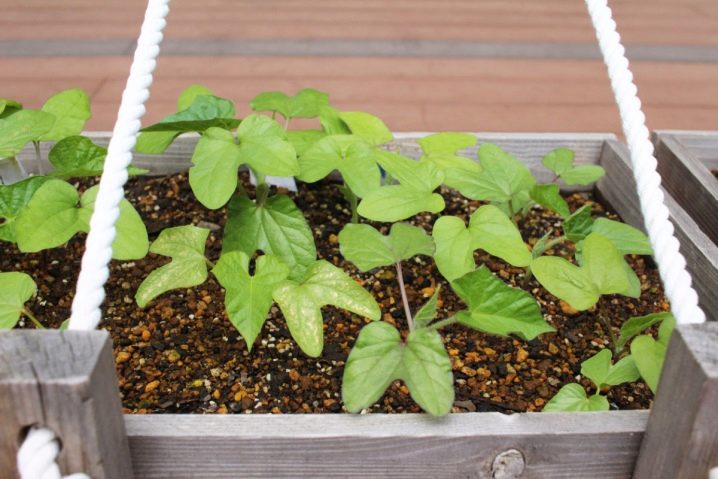
How to take care of it properly?
Humidity and watering
- Morning glory needs regular but moderate watering. In the summer, watering is carried out every day, but you need to be sure that there will not be an excess of water at the base.
- In winter, watering once a week or less is sufficient. You just need to make sure that the soil does not dry out.
- Morning glory does not need high humidity. However, she likes spraying, which can be done up to 2 times a day.

Soil and fertilizers
Morning glory prefers a loose and permeable base. You can buy ready-made primers from a specialist store. You can add to them vermiculite and coconut. Some species prefer substrate for cacti.
At the stage of active plant growth - that is, from early spring to the end of summer - top dressing must be carried out up to 3 times a week. You can use fertilizers designed for cacti or flowering crops.



Cropping and grabbing
At the end of flowering, removing wilted flowers is recommended. In September, it is also required to cut off old and damaged shoots. Pruning is also carried out in the spring.
Pruning and trimming stimulates the growth of new shoots, improving the appearance of the plant.
Seedling care
- For seedlings, it is recommended to buy ready-made soil for flower plants and prepare the substrate yourself, combining components such as peat, sand and soil.
- The seedlings should be kept warm with good lighting.
In order for the seeds to grow faster, you need to cover the crops with plastic wrap or glass to create a greenhouse effect.
- If the weather changes in an undesirable direction, additional lighting is required.
- The recommended temperature is around +22 degrees Celsius.
- It is recommended to install rods around the seedlings as a support.
- On the balcony, crops are grown under the same conditions as outdoors. It is necessary to provide the plant with support so that the shoots do not fall to the floor.

Seed collection
After the flowers have disappeared, a brown box will begin to form in their place. We must give it time to dry and open up. This will happen in about a month. It is then recommended to collect the seeds and pour them into a paper bag.

Reproduction methods
Generally, the morning glory has 4 breeding methods. Let's consider them briefly.
- Self-seeding. There is an independent discharge of ripe seeds, which hibernate in the soil and break out in the spring.
- The aforementioned multiplication by seeds, when they are collected by hand and in the spring they are planted on a personal plot.
- Planting seedlings at home and the subsequent transfer of seedlings to open ground.
- Cutting method not as common as the previous ones.Suitable only for some varieties of morning glory.


Diseases and pests
First, consider the diseases that morning glory is susceptible to.
Fungal infection of the leaves
Symptoms:
- brown spots on leaves with concentric rings resembling a target;
- usually old leaves are affected, which may be surrounded by a yellow halo;
- small gray-black oval foci can be found on stems and leaf petioles and sometimes on the leaves themselves;
- the lesions of the stem and cutting are enlarged and often confluent.
Petiole and leaf disease is much more damaging than leaf spots caused by Alternaria; stalk and petiole disease is a severe disease of sweet potatoes in East Africa.
Treatment: all residues from the sweet potato crop must be destroyed immediately after harvest. Plant only resistant or tolerant varieties.

Black rot
Symptoms:
- stunted, withering plants;
- yellowing;
- drooping leaves;
- round brown-black spots of rot on tubers.
Rot continues to develop in stored tubers.
Treatment:
- seed should be sown without diseases;
- should not be planted in places where the plant has been grown in the previous 3-4 years;
- The seed should be treated with a suitable fungicide before planting.


Rotting roots and stems
Symptoms:
- swollen and distorted stem base;
- deep dark rot that spreads deep into the tuber and forms elliptical cavities;
- growth of white mold.
The disease can be transmitted by contaminated seed.
Treatment:
- illness is usually not a problem if good sanitation is carried out;
- for sowing, select only seeds without diseases;
- treat seed roots with a suitable fungicide before planting.


Bacterial soft rot
Symptoms:
- brown or black spots on stems and cuttings that expand quickly and cause soft rot on the stem;
- the stem can collapse, leading to the wilting of several vines;
- the whole plant may die;
- the roots can form patches of soft rot that are initially colorless but eventually brown.
Symptoms develop after hot weather.
Treatment:
- avoid damage to the roots during storage at all stages of growth;
- plant only disease-free seed;
- The vines for transplanting should be pruned above the soil surface.

Bacterial wilting
Symptoms:
- new shoots wither, their bases become watery and take on a yellow-brown or dark brown color;
- Infection of healthy plants leads to the fact that the lower parts of the stems are also saturated with water and acquire a color similar to that of infected sprouts;
- yellow-brown stripes may develop inside the roots.
Treatment: for planting, only disease-free roots should be used, and planting should be carried out only in places free from disease.


Leaf and stem scab
Symptoms:
- small brown spots on the leaves that become corky in texture and cause the veins to shrink, which in turn causes the leaves to curl
- stem lesions - they are slightly raised and have a purple or brown center with light brown edges.
Treatment:
- avoid using overhead watering;
- use only healthy planting material;
- the use of appropriate fungicides can help fight disease.


Smallpox morning glory
Symptoms:
- poor plant growth;
- round dark brown cork formations on tubers V-shaped in cross-section;
- cracked and distorted tubers resembling dumbbells;
- rotting roots.
Treatment:
- the most effective method of combating this disease is the use of resistant varieties;
- if there are no such varieties, then the soil should be kept at a low pH, which is unfavorable for the pathogen;
- Fumigating the soil prior to planting can be an effective method for reducing disease incidence.

Now let's talk about what pests are most dangerous for morning glory.
Omphisa anastomosalis (bloodworm)
Symptoms:
- the larvae penetrate the trunk leading to the roots;
- damage in the crown area leads to wilting, yellowing and death of plants;
- holes can be easily identified by the presence of faeces on the soil surface and holes in the stem.
Treatment:
- keep the field free of weeds;
- use planting material that has been tested for the absence of eggs and larvae;
- use pheromone traps to control the presence of insects.

Phyllophaga ephilida (white larva)
White larvae are the larvae of scarab beetles, commonly referred to as May beetles. The larvae are white and C-shaped. They usually feed on soil, organic matter and plant materials.
Symptoms:
- pathogens feed on underground parts, including the main stem and roots;
- they also feed on tubers by making tunnels;
- the infected plant withers and dies over time.
Treatment:
- deep summer plowing exposes the larva and pupa present in the soil;
- provide adequate drainage in the soil to avoid excess moisture;
- the use of biocontrol reagents (such as the bacteria Bacillus popilliae and B. lentimorbus) kills the larvae.


For more information on planting and caring for morning glory, see below.


































































































The comment was sent successfully.